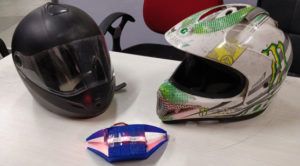When Prateek Kumar was at Delhi College of Engineering (DCE), he experienced a road accident near campus — which turned out to be a vital turning point in his life. That experience in 2016 not only transformed the way he approached his life but it also gave him a purpose: to make a device that would guarantee timely help in case of a road accident.
 “We all might remember someone who was hurt or lost a family member in a road accident owing to the reason, help did not arrive in time. It’s quite sad and the sad reality that we are living in. This requires to change,” says Kumar. “I wanted to bringing this change through my comprehensive experience in developing solutions based on the Internet of Things (IoT) and software, from conceptualizing to generation.”
“We all might remember someone who was hurt or lost a family member in a road accident owing to the reason, help did not arrive in time. It’s quite sad and the sad reality that we are living in. This requires to change,” says Kumar. “I wanted to bringing this change through my comprehensive experience in developing solutions based on the Internet of Things (IoT) and software, from conceptualizing to generation.”
Kumar fixed his mind on building a device that would be competent of “sensing” the intensity of an accident. For example, should one occur, it would send out relevant information to emergency services or a nearby hospital, while also informing the victim’s family members. This would all happen within seconds of the accident.
The 23-year-old entrepreneur decided a smart helmet, which combined a chip or device in the existing headgear, was the ideal way to fit the sensing technology. This made sense with the large number of scooters and bikes on the road in India.
“I looked up sources online and came across some sporty helmets in the European markets featuring a GoPro camera and other gizmos. Those didn’t align with what I had in mind and were quite expensive too,” he shares. “I wanted to make a cost-effective smart circuit or device that could either be embedded or retrofitted in a helmet.”
Most importantly, the device had to work well with the typical Indian road conditions and be something drivers would easily become accustom to. “Then, in 2017, along with some friends, I began working on finding a viable offering for the Indian market. As it called for significant investments, I also wrote a software program and sold it to my college to raise money for this project,” recounts Kumar.
In early 2017, the team also received some funding from the Spark-up Idea Fund, a seed fund for entrepreneurial ideas hosted by iCreate, the technology business incubation center of the Gujarat government. Students and innovators at various engineering colleges across India can apply for the Spark-up Fund. “A few interview rounds follow this, and then winning entries are offered up to Rs 50,000 in funding to enable students and innovators to take their respective projects to the next level of development,” he says.
The startup
After graduating in 2018, Kumar registered his venture, Vida Salvateur International Pvt Ltd (VSIPL), under the government’s Startup India scheme. The company’s name translates to life-saving in Spanish and French – vida is Spanish for “life,” and salvateur is French for “saving.”
Kumar’s smart helmet and chip will be marketed under the brand Motobuddy. VSIPL is in the process of registering the trademark and copyright for the brand and its handcrafted logo design. So far, about Rs 25 lakh has been invested in the business, including a grant of Rs 10 lakh received in July last year under the Nidhi Prayas scheme of the Department of Science & Technology, Government of India via IKP Eden, Bengaluru, which is India’s first hardware product incubator.
“Every year, two batches are rolled out for this scheme. One can directly apply to incubators that are listed under this program. The funding offered is a huge support for innovators wanting to start their entrepreneurial journey,” he explains.
When Kumar and his friends started developing the smart helmet, the circuit designed to power the device was so large that it covered an entire helmet. Streamlining the method to an optimal size and making it aesthetically appealing was critical to ensure the headgear would be marketable. After two years of hard work and numerous iterations, Kumar was successful in reducing the bulky circuit to a coin-sized chip.
Over the last two years, the company has worked extensively to fine-tune the innovation to detect and send out alerts on an accident accurately. “It was quite a challenge to reduce the circuit to its present size. A lot of prototyping with the right set of manufacturers and components went into making this happen,” he says.
The startup currently has 18 members handling various operational functions. Kumar brings extensive experience in drones, software development, and IoT solutions to the table. Holding the CTO position in the business is Manoj Saxena, a gold medallist from DCE, master’s from IISc, and a Ph.D. from IIT Delhi and Stanford University. With an MBA degree from INSEAD, Venugopal Gupta is the company’s business advisor and mentor.
Currently, Vida Salvateur is hoping to secure a fresh round of funding of about Rs 1 crore to so the product can go into final development.
 How it works
How it works
Motobuddy’s technology can be collaborated with a mobile handset via Bluetooth. A mobile application has been created already for this purpose and will be made accessible for downloads on the Google Play Store and iOS App Store at the time of official launch. The user can then populate emergency contact information and personal health-related details, such as medical conditions, allergies, and any existing ailments after listing on the app.
The reason for integrating the device in helmets is to motivate users to remember their headgear on every ride, Kumar says. The invention also gives out a red light using LEDs, thereby enhancing the clarity of the rider on the road while riding. In case of an accident, the IoT-enabled device recognizes it but doesn’t send out an alert for 30 seconds. Through this brief period, if the accident isn’t severe, the rider can eliminate the automated activation process. If the warnings aren’t cancelled, the device sends out information in the form of a message to the nearest hospital with information of the accident, its impact, and location.
Based on this data, the hospital will be able to transmit emergency services, either an exceptional one or a necessary ambulance, to the accident spot. Motobuddy is working on intorducing a network of hospitals in Noida, in other parts of Delhi-NCR, and ultimately across the country. The company is also in the means of onboarding emergency ambulance assistance providers into its system.
“In case the nearest hospital is not in our system, our administrators monitoring the system will call and alert a hospital about the occurrence. If the hospital does not act within a set time, the system will send another message to alert the next-nearest dispensary,” he says.
The road ahead for the team is interesting as they have conducted on-road trials over the past few month, with 25 of the chips tested on the way already. The information from these rides and simulated accidents has been supplied into the system and analyzed, and the devices have been tweaked according to the findings.
“For example, the motorcycle or scooter rider could experience a big jolt by dropping into a pothole or on irregularly shaped speed breakers. An average sensor could misread such incidences as an accident. To tackle this situation, exceptional sensors have been designed to recognize accidents from incidences of jolts and bumps carefully,” says Kumar. “Similarly, there are a few other things that are different to the smart chip. I can’t share more details at this platform, though.”
The startup has asked for patents for the chip and the smart helmet about 18 months ago and is expected to get them by the end of this year. These licenses are India-specific as getting global licenses would be a cost-intensive operation.
“However, once the supplementary funding comes in and the smart chip gets good friction in the market, we plan to apply for global patents and acquire the intellectual property too.”
The company initially plans to roll out the smart chip valued at Rs 1,200 and the retrofitted helmet valued at Rs 2,500 will be introduced at a later stage. It also plans to offer an AI-driven engine that will present advanced driving analytics (ADAs), including driving speed and performance and location tracking. An annual subscription-based setting, ADA, will be offered to Motobuddy users at a nominal price to be disclosed at the time of launching the product in the market.
VSIPL eventually plans to include insurance and health policy information with the smart helmet. This is being done mainly to facilitate cashless claims at various hospitals in the network, he says. Taking the Motobuddy product and service offerings international also forms a part of the company’s business expansion plans.
“We have streamlined everything that’s required to produce the chip and the smart helmet commercially. We should be able to hit the market within three months from receiving the funding,” says Kumar.
Filed Under: Tech Articles


Questions related to this article?
👉Ask and discuss on EDAboard.com and Electro-Tech-Online.com forums.
Tell Us What You Think!!
You must be logged in to post a comment.